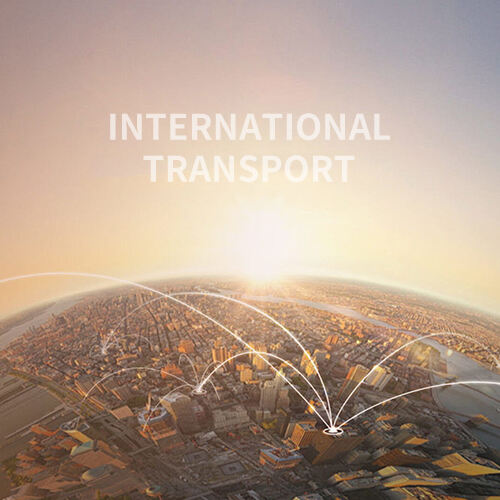Navigating Supply Chain Disruptions and Building Resilience In North America Logistics

Understanding the Rise in Supply Chain Disruptions Across North America Logistics
The logistics networks across North America have been hit hard by disruptions starting in 2023, according to recent data where around two thirds of companies cited labor shortages and backed up ports as major problems (FMCSA 2023). Things got worse when geopolitical issues collided with wild weather patterns and shifting what people want to buy, creating serious delays especially at big shipping hubs such as Los Angeles and Savannah. Take the massive Canadian wildfires in 2023 for instance they knocked out several key rail routes which sent cross border trucking costs shooting up by nearly a quarter overnight.
Core Principles of Supply Chain Resilience and End-to-End Visibility
Building business resilience really comes down to three main things: knowing where suppliers stand at all levels, getting live data flowing across departments, and keeping inventory flexible enough to adapt quickly. Businesses that focus on seeing their entire supply chain saw delivery problems drop by around 40% last year when compared with companies still stuck in old school systems. According to research from Deloitte released in 2024, organizations adopting smart risk management tools powered by artificial intelligence cut their time to bounce back from unexpected issues by nearly half, thanks largely to those fancy prediction models they run.
Case Study: Managing Disruptions During the 2023 ILA Port Strikes
The ILA strike that shut down East Coast ports for over two weeks back in 2023 forced a major logistics firm to get creative fast. They managed to redirect around 72 percent of their cargo traffic through Gulf Coast terminals thanks to their real time container tracking system. The company had already lined up backup rail connections months earlier and used some pretty advanced routing software to figure out the best paths. This proactive approach saved them somewhere around eight million seven hundred thousand dollars in lost revenue during those chaotic days. Shows just how important it is to have plans in place when unexpected disruptions hit the supply chain.
Strategic Shifts: Dual Sourcing and Real-Time Data for Risk Mitigation
Post-2023, 61% of North American manufacturers adopted dual sourcing, reducing dependency on single-region suppliers. Real-time freight monitoring tools like IoT-enabled pallets have slashed shipment theft risks by 34% (PwC 2024), while blockchain-based customs documentation cut border clearance times by 18 hours at US-Mexico checkpoints.
Emerging Trend: Increased Investment in Supply Chain Risk Preparedness
Corporate investment in supply chain resilience surged to $740B globally in 2024, with 83% of logistics leaders allocating funds to predictive modeling and regionalized warehousing. This shift reflects lessons from the 2023 crises, where companies with robust risk frameworks outperformed competitors by 27% in revenue retention during disruptions.
Overcoming Cross-Border Trade Complexities with Canada, Mexico, and Puerto Rico
Key Regulatory and Infrastructure Barriers in North America Logistics
Cross border shipping between North American countries continues to hit roadblocks because safety regulations just don't match up across borders, plus many ports of entry are still dealing with outdated infrastructure from decades ago. According to research published by the Council of Supply Chain Management Professionals last year, nearly half (that's 43%) of businesses report real problems getting their products certified for sale in Mexico. Meanwhile over on the Canadian side, about a quarter (28%) of shipments get rejected simply because they fail to meet those bilingual labeling rules. All this creates a situation where companies need someone who really understands how USMCA works - that big trade agreement between the US, Mexico and Canada. And things are going to get even more complicated soon since there's a required review of the entire treaty coming up in 2026 that could bring changes nobody expects.
Impact of Tariff Volatility and Trade Policy Uncertainty
Tariff threats over recent months have pushed border crossing times up around 17 percent at major US-Mexico checkpoints according to Inbound Logistics data from 2025. With nearly 840 billion dollars worth of goods moving between these two countries every year, the entire trade relationship sits on pretty shaky ground when policies change overnight. We saw this happen last summer when customs inspections got much stricter in Q2 2024, leading to some serious backups where trucks sat stuck for over 30 hours just outside Laredo. Many businesses are adjusting their spending habits too. Around 15 to maybe even 20 percent of what companies spend on logistics now goes toward preparing for potential tariffs, compared to only about 8 percent back in 2022. That represents a big chunk of money being set aside for something that might never actually materialize.
Case Study: 2024 US-Mexico Border Delays Due to Heightened Customs Scrutiny
A major automotive parts supplier faced $2.4 million in demurrage fees when Mexican officials implemented new origin verification protocols. Their crisis response demonstrated three critical adaptations:
- Deploying blockchain-enabled certificates of origin
- Establishing regional staging warehouses in Nuevo León
- Training 160+ staff on updated AEO (Authorized Economic Operator) requirements
Solution: Technology-Driven Compliance and Streamlined Cross-Border Operations
Leading firms now reduce customs clearance times by 40% using AI-powered document processors that automatically align shipments with evolving trade agreements. Real-time track-and-trace systems have decreased border-related stockouts by 31% since 2023, while automated duty calculators prevent 92% of classification errors according to BorderTech 2025 benchmarks.
Freight Pricing Volatility and Capacity Constraints in 2025
Surging Freight Rates: Key Drivers in the 2025 North America Logistics Market
North American logistics companies are really feeling the squeeze these days because of wild swings in diesel prices, ongoing supply chain snarls, and customers who just cant seem to predict what they want. Most industry experts think trucking volumes will go up around 1.6 percent by 2025, which means even tighter capacity and wilder price swings than weve seen before. With more tenders getting rejected all the time, carriers have started leaning heavily toward long term contracts instead of relying on spot markets. This pattern gets especially intense during busy seasons when there simply aren't enough trucks available, sometimes causing spot rates to jump anywhere between 30 and 40 percent overnight. Given all this chaos, it makes sense why smart shippers are looking at ways to build more flexibility into their contracts and invest in tools that give them live updates on freight conditions across different regions.
Economic Instability and Its Impact on Logistics Costs and Capacity
Changes in trade policies, slower than expected GDP growth predictions around 2.1% for next year, plus all these wild weather events are making prices really unstable right now. Logistics companies report that nearly 1 out of 5 international shipments got stuck in the first quarter of 2025 because customs inspections have gotten stricter lately. When things get delayed at borders, it pushes up those local transport fees and keeps cargo sitting longer in warehouses. Mid sized shipping firms are feeling this pain too, with about two thirds having to dig into their budgets and set aside extra money just in case something goes wrong again. Companies need to start thinking ahead and running different what if scenarios so they can keep costs down without sacrificing how reliable their services remain for customers.
Case Study: Spot Market Rate Spikes During Q1 2025 Carrier Shortages
One regional auto parts distributor saw spot rates jump by almost 35% in early 2025 when nearly a quarter of their usual carriers pulled out because of massive backups at west coast ports. The company started using smart software platforms for freight matching and expanded their network to work with local LTL companies too. These changes cut down their dependence on unpredictable spot markets by over 40%, all while keeping deliveries on time around 98% of the time. Looking back, it makes sense why combining different sourcing strategies works so well when supply chains get disrupted like they did during those recent shipping crises.
Addressing Driver Shortages and Capacity Gaps Under FMCSA Regulations
According to the FMCSA data, there's going to be around 78,000 fewer truck drivers available in 2025 compared to last year when they counted about 69,000 missing drivers already. The new rules mandating those fancy ADAS tech installations have definitely put the brakes on expanding fleets across the board. About one third of transportation companies are basically saying these compliance expenses just aren't worth it right now for growing their operations. Some big players in the industry are trying different approaches though. They've started setting up apprenticeships aimed at younger folks below age 45 while also investing in smart routing software that somehow manages to squeeze out nearly 20% better efficiency from existing assets. Getting everyone at the table seems essential if we want to fix these persistent capacity issues facing the sector today.
Technology and Automation Transforming North America Logistics
Accelerating Digitalization: Data Analytics and Visibility in Logistics
North America logistics sector is embracing advanced analytics to counteract fragmented data ecosystems, with 63% of operators now prioritizing real-time visibility tools to mitigate delays (Market Data Forecast 2025). Modern platforms integrate IoT sensors and cloud-based tracking, enabling stakeholders to monitor shipments, predict bottlenecks, and optimize warehouse workflows.
AI-Driven Optimization for Routes, Inventory, and Demand Forecasting

AI algorithms are reshaping decision-making by analyzing historical and real-time data to optimize routes, reduce fuel costs, and balance inventory. Machine learning models now predict regional demand spikes with 89% accuracy, allowing companies to adjust stock levels dynamically and avoid overstocking.
Case Study: Robotics and Automation in North American Warehousing
A leading e-commerce giant reduced order processing time by 40% after deploying autonomous mobile robots (AMRs) and AI-guided sorting systems. This shift underscores the growing reliance on automation to address labor shortages and improve throughput in high-volume distribution hubs.
Growing Integration of AI and Machine Learning in Logistics Planning
From predictive maintenance to carrier selection, AI tools now automate 55% of routine planning tasks. A 2024 study on AI adoption revealed that firms using machine learning for load optimization lowered freight costs by 18% while improving delivery reliability.
Scaling Automation for Long-Term Efficiency and Competitive Advantage
Forward-thinking organizations are transitioning from pilot projects to enterprise-wide automation, combining robotic process automation (RPA) with blockchain for end-to-end traceability. This strategic shift not only cuts operational costs but also future-proofs supply chains against evolving market demands.
Meeting E-Commerce Demands Through Last-Mile and Sustainable Innovation
E-Commerce Growth and Its Strain on North America Logistics Networks
The e-commerce market across North America is expected to hit around $1.7 trillion by 2025, which is putting serious pressure on logistics systems as parcel volume grows at roughly 23% each year. Warehouse operators have had to expand their facilities by about 15% since early 2023, but many are finding that old school hub-and-spoke distribution just doesn't cut it anymore when dealing with these kinds of volumes. Logistics companies in the region are actually spending about 31% more money to fulfill those same day delivery orders than they do for regular shipping services. This cost difference is becoming a real problem for businesses trying to balance customer expectations with profit margins.
Last-Mile Delivery Challenges in Urban and High-Density Areas
Getting packages to people living in city centers costs almost 50% more than delivering to suburbs because of all the traffic jams and limited parking spots everywhere. Take places like New York City or Toronto where nearly 4 out of 10 late deliveries happen simply because the truck couldn't get through on the first try. This creates all sorts of problems down the line for delivery companies. And it gets worse when looking at environmental impact too. Cities packed with buildings and people are responsible for over half of all emissions from logistics operations across North America even though they cover just around a fifth of the actual delivery distance traveled by trucks.
Innovative Solutions: Micro-Fulfillment Centers and Multi-Modal Delivery
Micro-fulfillment centers within 10 miles of urban hubs reduce last-mile distances by 47% while improving inventory turnover rates. Companies combining electric cargo bikes with AI-optimized routing achieve 19% faster delivery times in metro areas. Multi-modal strategies using dockless delivery lockers have reduced per-package costs by $3.20 in pilot markets.
Sustainability in Logistics: Overcoming EV Infrastructure and Cost Barriers
While electric delivery fleets lower emissions by 89% compared to diesel equivalents, North America logistics operators face a $21,000 per-vehicle cost premium. The Last Mile Delivery Market now prioritizes hydrogen-fuel-cell vehicles for long-haul routes, with 14 major carriers testing prototypes that achieve 450-mile ranges on single charges.
Balancing Efficiency, Cost, and Environmental Goals in Modern Supply Chains
Leading providers achieve 19% cost reductions through dynamic route optimization while maintaining 97% on-time delivery rates. Real-time emissions tracking enables carbon-neutral shipping options chosen by 43% of consumers, creating $2.8 billion in incremental North America logistics revenue through premium sustainability services.
FAQ
What are the main drivers of supply chain disruptions in North America?
Labor shortages, geopolitical issues, extreme weather patterns, and shifting consumer demand are major drivers of supply chain disruptions affecting logistics across North America.
How can supply chain resilience be improved?
Supply chain resilience can be improved by implementing end-to-end visibility, utilizing AI for risk management, ensuring flexible inventory management, and focusing on dual sourcing strategies.
What are some technological advancements used to mitigate supply chain issues?
AI-powered document processors, IoT-enabled tracking systems, blockchain for customs documentation, and real-time data analytics are some technological advancements helping to mitigate supply chain issues.
How are logistics companies dealing with last-mile delivery challenges?
To address last-mile delivery challenges, companies are using micro-fulfillment centers, electric cargo bikes with AI-optimized routing, and dockless delivery lockers to improve efficiency and reduce costs.
What role does sustainability play in modern logistics?
Sustainability is crucial in logistics, with a focus on reducing emissions through electric and hydrogen-fuel-cell vehicles, real-time emissions tracking, and offering carbon-neutral shipping options.
Table of Contents
-
Navigating Supply Chain Disruptions and Building Resilience In North America Logistics
- Understanding the Rise in Supply Chain Disruptions Across North America Logistics
- Core Principles of Supply Chain Resilience and End-to-End Visibility
- Case Study: Managing Disruptions During the 2023 ILA Port Strikes
- Strategic Shifts: Dual Sourcing and Real-Time Data for Risk Mitigation
- Emerging Trend: Increased Investment in Supply Chain Risk Preparedness
- Overcoming Cross-Border Trade Complexities with Canada, Mexico, and Puerto Rico
- Freight Pricing Volatility and Capacity Constraints in 2025
- Technology and Automation Transforming North America Logistics
- Accelerating Digitalization: Data Analytics and Visibility in Logistics
- AI-Driven Optimization for Routes, Inventory, and Demand Forecasting
- Case Study: Robotics and Automation in North American Warehousing
- Growing Integration of AI and Machine Learning in Logistics Planning
- Scaling Automation for Long-Term Efficiency and Competitive Advantage
-
Meeting E-Commerce Demands Through Last-Mile and Sustainable Innovation
- E-Commerce Growth and Its Strain on North America Logistics Networks
- Last-Mile Delivery Challenges in Urban and High-Density Areas
- Innovative Solutions: Micro-Fulfillment Centers and Multi-Modal Delivery
- Sustainability in Logistics: Overcoming EV Infrastructure and Cost Barriers
- Balancing Efficiency, Cost, and Environmental Goals in Modern Supply Chains
-
FAQ
- What are the main drivers of supply chain disruptions in North America?
- How can supply chain resilience be improved?
- What are some technological advancements used to mitigate supply chain issues?
- How are logistics companies dealing with last-mile delivery challenges?
- What role does sustainability play in modern logistics?

